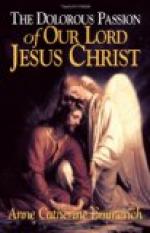younger. They were commonly called Dismas and
Gesmas, and as I forget their real names I shall distinguish
them by these terms, calling the good one Dismas, and
the wicked one Gesmas. Both the one and the other
belonged to a band of robbers who infested the frontiers
of Egypt; and it was in a cave inhabited by these
robbers that the Holy Family took refuge when flying
into Egypt, at the time of the massacre of the Innocents.
The poor leprous child, who was instantly cleansed
by being dipped in the water which had been used for
washing the infant Jesus, was no other than this Dismas,
and the charity of his mother, in receiving and granting
hospitality to the Holy Family, had been rewarded
by the cure of her child; while this outward purification
was an emblem of the inward purification which was
afterwards accomplished in the soul of Dismas on Mount
Calvary, through that Sacred Blood which was then
shed on the cross for our redemption. Dismas
knew nothing at all about Jesus, but as his heart was
not hardened, the sight of the extreme patience of
our Lord moved him much. When the executioners
had finished putting up the cross of Jesus, they ordered
the thieves to rise without delay, and they loosened
their fetters in order to crucify them at once, as
the sky was becoming very cloudy and bore every appearance
of an approaching storm. After giving them some
myrrh and vinegar, they stripped off their ragged clothing,
tied ropes round their arms, and by the help of small
ladders dragged them up to their places on the cross.
The executioners then bound the arms of the thieves
to the cross, with cords made of the bark of trees,
and fastened their wrists, elbows, knees, and feet
in like manner, drawing the cords so tight that their
joints cracked, and the blood burst out. They
uttered piercing cries, and the good thief exclaimed
as they were drawing him up, ’This torture is
dreadful, but if they had treated us as they treated
the poor Galilean, we should have been dead long ago.’
The executioners had divided the garments of Jesus,
in order to draw lots for them; his mantle, which
was narrow at the top, was very wide at the bottom,
and lined over the chest, thus forming a pocket between
the lining and the material itself; the lining they
pulled out, tore into bands, and divided. They
did the same with his long white robe, belt, scapular,
and under-garment, which was completely saturated with
his Sacred Blood. Not being able to agree as to
who was to be the possessor of the seamless robe woven
by his Mother, which could not be cut up and divided,
they brought out a species of chessboard marked with
figures, and were about to decide the point by lots,
when a messenger, sent by Nicodemus and Joseph of
Arimathea, informed them that there were persons ready
to purchase all the clothes of Jesus; they therefore
gathered them together and sold them in a bundle.
Thus did the Christians get possession of these precious
relics.
CHAPTER XLI.




